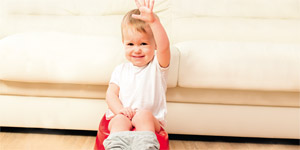Toddler
4 min Read
Helpful hints for dealing with the ins and outs of constipation

August 18, 2015
Toddler
4 min Read

August 18, 2015


Two-year-olds aren’t too discreet when it comes to bodily functions. So when you spot your toddler standing on tiptoe, crossing his or her legs, squatting or getting red in the face, you might assume your kid is working on a bit of business. In fact, these could be signs your child is withholding, not dropping, a load.
It’s a normal part of a child’s development to learn how not to poop when they’re not near a toilet. But not every kid masters this process perfectly, says Dr. Bob Issenman, Chief of Pediatric Gastroenterology and Nutrition at McMaster Children’s Hospital in Hamilton, Ont. “Step one is holding back, but step two is letting go. Certain kids become champions at step one, and not so good at step two!”
When toddlers hold it in, it could simply be because they’re distracted – why take a time-out for the toilet when you’ve got a room full of toys? Sometimes they’re having trouble relaxing (an essential part of the process), perhaps because the toilet is intimidating or a caregiver is pushy.
Unfortunately, kids who can’t or won’t let it go often end up constipated. The stool becomes hard and dry as too much water is absorbed from it, making it painful to pass and creating a vicious cycle of trying to hold it the next time. Eventually this can even enlarge the rectum and interfere with the urge to go. “It blunts sensation,” says Dr. Issenman. “Then they can have accidents, because they’re not getting the messages.”
Other signs of constipation in your toddler may include tummy pain or reduced appetite. Your child may even experience tiny tears (anal fissures) that leave bright blood on the surface of the stool.
About one in six toddlers struggle with the problem. Naturally it then becomes a struggle for parents, who may feel distressed over their child’s painful poops, frustrated by soiled underwear, and stressed because toilet training isn’t on schedule. But these strategies can help.
Your child needs to toilet train at his own pace – and that might take months, not weeks. Try not to pressure, blame or rush your toddler on the toilet. Let him read books or sing a song to allow his system to work more naturally.
Dinner, bath, toilet. If you routinely put children on the potty at the same time every day, their bodies often start preparing to poop naturally. (Tip: If your kid is terrified of the toilet, put her in a pull-up for 30 minutes instead. She’ll still develop a reflex to poop at the same time each day.)
Use a potty chair or an adapter seat so your child feels secure. If his feet don’t reach the floor, give him a footstool for support.
Children tend to drink the fluids they need. But excess calcium from drinking too much milk can contribute to constipation. The milk may also be displacing high-fibre and other essential foods in their diet. Limit milk to 750 ml a day (and juice to 250 ml).
Constipation in toddlers is rarely a sign of an underlying health problem. But seek advice from your doctor if your toddler seems distressed over toileting, or if you’re stuck in a discouraging pattern. A doctor can also help treat anal fissures, and may suggest a laxative (see sidebar). Tests are rarely needed. Be wary of alternative therapies, such as special diets. “These are very common, simple behavioural problems,” say Dr. Issenman. “You want to demystify them, not make them bigger than they really are.”
Your doctor may recommend your toddler take a laxative known as polyethylene glycol (PEG) 3350. Using laxatives for the short-term may prevent a months or even years-long struggle. Here’s what else to know:
Originally published in ParentsCanada magazine, September 2015.